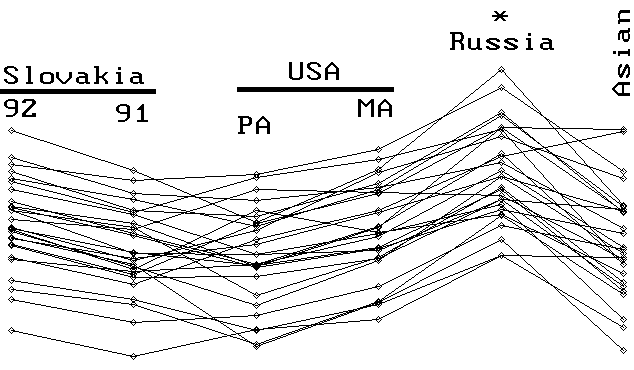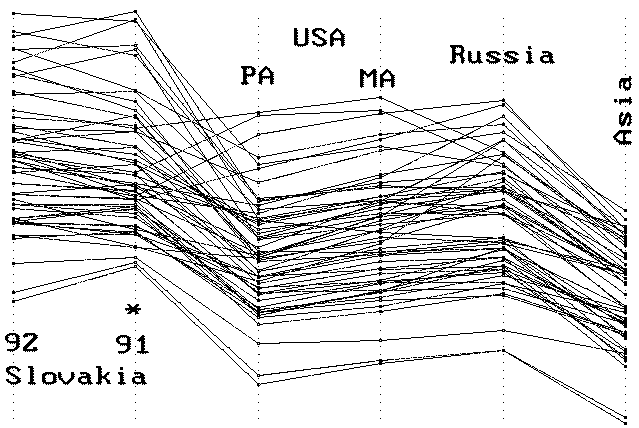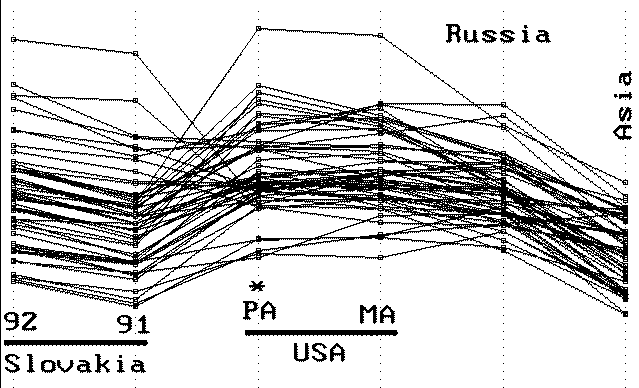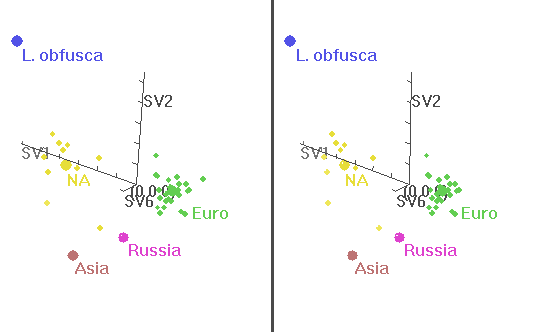Discrimination of Gypsy Moth Populations Based on Wing Venation

Log-likelihood discriminant scores for
individual Russian Lymantria dispar wing membership
in the Russian population, two Slovakian populations
two North American populations and one Asian population. This plot is an
output of the PLANAR software package available free by downloading from
this site. The scores
of each wing are connected by a line so that the highest discriminant
score for that wing can be determined. In most cases the Russian wing
obtained its highest score from the Russian Discriminant Function.

Log-likelihood discriminant scores for
individual Slovakia 1991 Lymantria dispar wing membership as above.
In most cases a Slovakian 1991 wing gets its highest discriminant score from
one of the Slovakian discriminant functions. Slovakian 91 or 92 functions do
not discriminate between one another.

Log-likelihood discriminant scores for
Pennsylvania individual Lymantria dispar wing membership as above.
In most cases the Pennsylvania wing gets its highest discriminant score from
one of the USA discriminant functions. The MA and PA discriminant functions do
not discriminate well between one another.
Key to population symbols in above trees
- CZn - 6 populations, 1 to 6, from southern Slovakia in 1991
- SLnn - 16 populations, 1 to 19, from southern Slovakia in 1992
- MASn - 2 populations from Amherst, Massachusetts, USA in 1991 and 1992
- PAnn - populations from Pennsylvania in years 1988 and 1989
- Rus - population from Russia in 1992
Preliminary analysis of our discriminant data
Each population of gypsy moths represents the animals collected from a
single site. All populations are represented by a sample of at least
25 individual males.
The average positions of the 13 wing landmarks in each population were used
as the centers of elipsoidal confidence regions. Bivariate normality was
assumed for each landmark. The landmarks were found to be relatively
independent of each other and we proceded with the simple assumption that
the landmarks are independent. Then, the discriminant score
for each unknown wing was computed after fitting that wing to the average
positions of the reference population. These calculations were
accomplished using the
PLANAR
program, downloadable from this site. The resultant discriminant scores for
each wing of a population can be represented as a line connecting its scores
with respect to each reference population. Included here is a sample of the
Russian population tested for its membership in 2 Slovakian, 2 North American
and
2 Russian/Asian populations. As might be expected the Russian wings obtained
their highest discriminant scores from the Russian Discriminant Function.
When North American populations were tested in the same set of tests it was
clear that North American populations obtained equivalently large scores
from all North American Discriminant Functions.
Tentatively, we conclude
that one can discriminate between Asian, European and North American
populations but that within North American or within European populations
it is not possible to reliably predict from what sub-population a wing sample
has been drawn.
Analysis of a more extensive set of populations, including the above set,
are in preparation for publication. We are extending our analysis to use
the new Thin Plate Spline suite of analytic software produced by F. James
Rohlf and available through the
morphometrics WWW site.
 Stereo image of a principle component analysis of Thin Plate Spline analysed
North American, European, Asian and Russian populations of forewing landmarks
in shape space. This stereo image was prepared with Mage
from an analysis of averaged landmarks obtained using PLANAR. The
Principle Components were extracted from the thin plate spline analysis using
Rohlf's tpsRelw Ver. 1.07. Component scores 1, 2 and 6
are displayed. Single population averages of L. dispar from Asia and
Russia and the outgroup species Lymantria obfusca are depicted as large
spheres. The average populations of European and North American origin are
also depicted as large spheres while smaller spheres represent individual
populations within those regions. The '.kin' file of
this image is available which allows identification of individual populations
represented by each small sphere.
Stereo image of a principle component analysis of Thin Plate Spline analysed
North American, European, Asian and Russian populations of forewing landmarks
in shape space. This stereo image was prepared with Mage
from an analysis of averaged landmarks obtained using PLANAR. The
Principle Components were extracted from the thin plate spline analysis using
Rohlf's tpsRelw Ver. 1.07. Component scores 1, 2 and 6
are displayed. Single population averages of L. dispar from Asia and
Russia and the outgroup species Lymantria obfusca are depicted as large
spheres. The average populations of European and North American origin are
also depicted as large spheres while smaller spheres represent individual
populations within those regions. The '.kin' file of
this image is available which allows identification of individual populations
represented by each small sphere.
The cooperation and support of
USDA APHIS in our developing the
PLANAR software is acknowledged. Phil Kingsley of USDA
APHIS shared with me the Pennsylvania (PA88 and PA89) and Asian (Asia)
populations as well as the Lymantria obfusca wings. Bill Wallner,
of USDA Forest Service,
Northeastern Forest Experiment Station, Hamden, Conn.,
provided our Yakovlevka, Russia (Rus) population.
The extensive Slovakian populations came
from Julius Novotny of the Forest Research Institute at
Banska Stiavnica,
Slovakia.
Back to: |
Kunkel Home Page|
Biology Dept.|
UMass Home Page|




